Exploring the Art and Significance of Beaded Necklaces
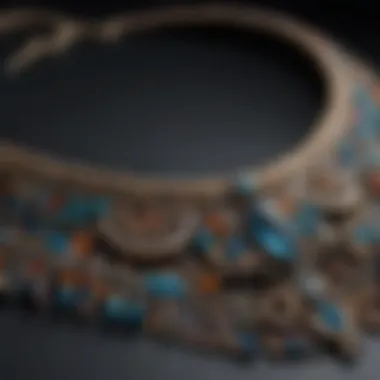
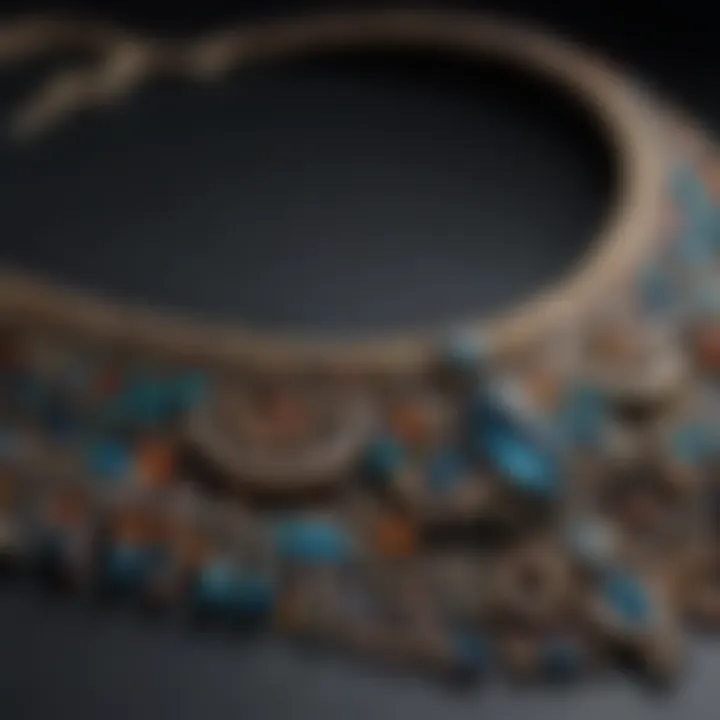
Intro
Beaded necklaces represent a unique blend of history, culture, and artistry. As we explore this intricate field, it is essential to understand not only the materials used but also the stories they tell. From ancient civilizations to contemporary fashion trends, these adornments possess both aesthetic and symbolic value. The following sections will unpack the layers surrounding beaded necklaces, including their origins, the craftsmanship involved, and their relevance in personal and cultural expression.
Gemstone Overview
Definition and Origins
Beaded necklaces are often made using a vast array of materials, but gemstones hold a prominent place in their design. Gemstones are naturally occurring minerals that are polished and cut to be used in jewelry. The practice of incorporating gemstones dates back to ancient times, where they were valued not only for their beauty but also for their supposed metaphysical properties.
Historical Significance
Gemstones used in beaded necklaces have varied significance throughout history. In ancient Egypt, for example, lapis lazuli symbolized royalty and was often found in the jewelry of pharaohs. Similarly, turquoise held sacred status among Native American cultures. Over time, these materials have evolved, often reflecting the cultural values and aesthetics of the societies that use them.
Gemstone Properties
Hardness and Durability
The hardness of a gemstone determines its durability and suitability for beaded necklaces. The Mohs scale of mineral hardness rates gemstones, where diamond ranks the highest at ten, while talc ranks the lowest at one. For beaded necklaces, materials like amethyst, which ranks at seven, provide a good balance of beauty and durability.
Color and Clarity
The visual appeal of gemstones is heavily influenced by their color and clarity. Factors such as hue, saturation, and tone contribute to a gemstone's overall appearance. Some popular gemstones used in bead-making include:
- Amethyst: Known for its purple hue.
- Onyx: Valued for its deep black color.
- Jade: Appreciated for its range of colors, primarily green.
An understanding of these properties aids designers and buyers alike in making informed choices about beaded necklaces.
"Understanding gemstone properties can significantly impact the selection of materials for creating beaded necklaces, influencing aesthetic appeal and longevity."
Through this article, we will further explore how these aspects contribute to not only the craftsmanship of beaded necklaces but also their significance in various cultures around the world.
Intro to Beaded Necklaces
Beaded necklaces are not merely decorative accessories but embody a rich tapestry of culture, history, and craftsmanship. Their significance spans across various societies and epochs, highlighting human creativity and expression. In this article, we delve into the world of beaded necklaces, exploring their intricate nature and multifaceted roles.
The allure of beaded necklaces lies in their diversity. The choice of materials varies widely, from natural elements like wood and stone to synthetic materials such as plastic and resin. Each type of bead carries its own story, offering insight into the environment and culture from which it originates. This variety enhances the appeal of beaded necklaces as unique pieces often used to convey individual identity or convey messages.
Moreover, beaded necklaces serve a deeper purpose beyond aesthetics. They often hold cultural significance, acting as symbols of status, spirituality, or community belonging. By wearing or creating these necklaces, individuals connect with their heritage and maintain traditions passed through generations.
Understanding the significance of beaded necklaces also involves recognizing the skills required in their creation. Whether through traditional hand beading techniques or modern innovations, the craftsmanship involved speaks to the dedication and creativity of the artisans. The methods of construction, pattern selection, and color combinations employed further add layers of meaning and intention to these adornments.
This section aims to provide a clear introduction to beaded necklaces, laying the groundwork for a deeper exploration into their history, artistry, and contemporary relevance. It is essential for enthusiasts, collectors, and jewelry designers who wish to appreciate the subtleties and brilliance inherent in each piece. Through this discussion, we hope to elevate the understanding of beaded necklaces and their lasting impact across cultures and time.
Historical Overview
Understanding the historical background of beaded necklaces is crucial for grasping their artistic and cultural significance. This overview connects the modern appreciation of these accessories to their rich past, highlighting how they evolved as tools for communication, status indicators, and personal expression. Such insights aid enthusiasts and craftsmen alike in appreciating not just the aesthetics of these items, but also their deeper meanings.
Origins of Beaded Necklaces
The origins of beaded necklaces can be traced back thousands of years, with archaeological findings suggesting their presence in ancient civilizations like Egypt, Mesopotamia, and the Indus Valley. Early beading utilized readily available materials like stones, shells, and bones. These early adornments often served functional purposes, acting as talismans or offerings in various rituals. For instance, ancient Egyptians crafted elaborate beads to accompany the deceased in their journey to the afterlife. This practice emphasizes the spiritual and ritualistic aspects of beaded necklaces, which transcended mere decoration.
Historians believe that these earliest necklaces not only held aesthetic appeal but also conveyed messages about the wearer's identity and social rank. The choice of material and design elements often pointed to the wearer’s wealth or tribal affiliation. This significance is still evident today in how individuals select beads based on cultural meanings or personal significance.
Cultural Significance Through Ages
Throughout history, beaded necklaces have mirrored societal changes and cultural exchanges across different epochs. In many indigenous cultures, necklaces are more than decorative items; they are integral to cultural identity. For example, in Native American cultures, beadwork represents ancestral traditions and storytelling, with each design element carrying specific meanings.
Moreover, the arrival of trade routes introduced diverse materials and styles, further enriching the craft of beading. The Silk Road is a prime example of how cultures influenced each other through the exchange of goods and ideas, leading to hybrid styles of beaded necklaces. This era marked a transition where beads became a symbol of not only adornment but also cultural fusion.
As societies modernized, beaded necklaces underwent a transformation, reflecting contemporary aesthetics while maintaining a connection to their historical narratives. They are now integral to fashion trends, yet they also carry a sense of heritage and continuity from ages past.
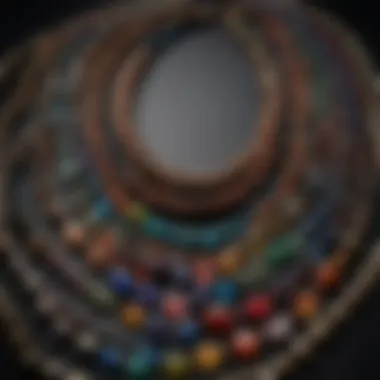
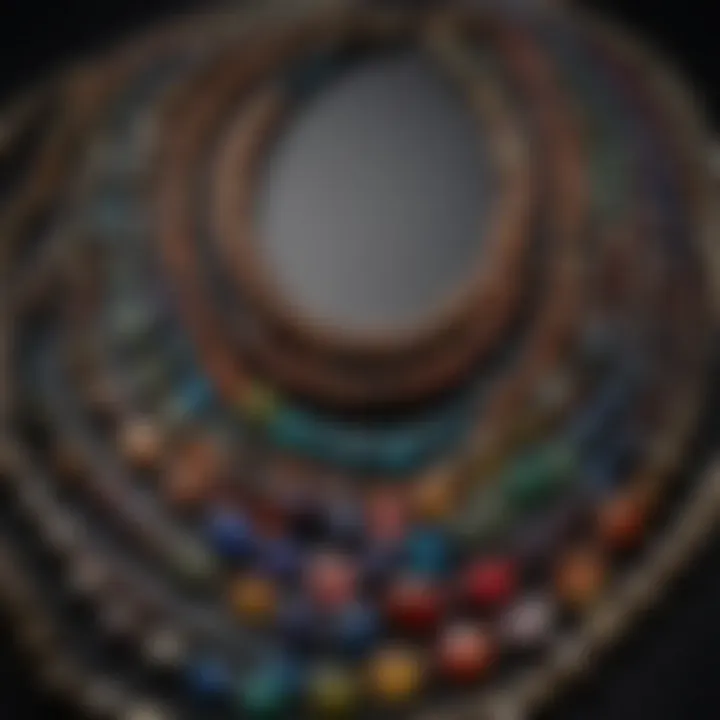
"Beaded necklaces are timeless creations that serve as a bridge between cultures, traditions, and personal expressions."
Materials Utilized in Beaded Necklaces
The selection of materials is crucial to the crafting process of beaded necklaces. Each type of material brings its own unique qualities and appeal, influencing appearance, weight, and even the meaning behind the piece. The materials used can define a necklace's style, and durability, and play a significant role in its care and maintenance. Understanding these materials can enhance an enthusiast's appreciation for the craftsmanship involved. Below are the primary categories of materials used in beaded necklaces.
Natural Materials: Wood and Stone
Natural materials like wood and stone have been used for centuries in jewelry making. Wood provides a light, organic feel to designs. It can be carved and shaped into various forms, allowing for intricate detail. Different types of wood also possess different colors and textures, which can give each piece its own distinctive look.
Stone, on the other hand, introduces a sense of permanence and durability. From agate to turquoise, each stone carries unique patterns, colors, and meanings. Stones can be polished to a high shine or left in their natural state, adding versatility in design. For many cultures, particular stones are believed to hold spiritual properties, making them significant in the crafting of necklaces.
Synthetic Alternatives: Plastics and Resins
With advancements in technology, synthetic materials such as plastics and resins have become prominent in beading. These materials offer a vast range of colors and styles at a fraction of the price of natural materials. They are lighter and more durable, making them popular for everyday wear.
They also allow for greater experimentation in design. However, there is usually an environmental concern associated with these materials. It's important for consumers to consider the ecological impact of using plastics and resins, and to explore brands that promote sustainability.
Metals and Their Role in Design
Metals play a specialized role in the aesthetics of beaded necklaces. Common metals used include gold, silver, and copper. Each metal brings its own set of benefits and drawbacks. Gold is often seen as a luxury material, revered for its lustrous shine and resistance to tarnish.
Silver offers a classic appeal and is more affordable but requires more maintenance to keep it shining. Copper has unique coloring that can develop a desirable patina over time.
In addition to their beauty, metals are often used in the structural elements of beaded necklaces. They can create clasps, spacers, and other functional components that are both decorative and practical. The choice of metal can thus significantly affect both the visual and tactile experience of the piece.
"The choice of materials reflects not just aesthetic preferences but also cultural values and environmental considerations."
Finale
In summary, the materials utilized in beaded necklaces not only define the look but also influence the physical characteristics of the piece. Each type of material—whether natural or synthetic—comes with its own benefits and potential drawbacks. An awareness of these materials enhances the appreciation for the artistry involved in creating beaded jewelry.
Beading Techniques and Styles
The exploration of beading techniques and styles is crucial in understanding the full spectrum of beaded necklaces. These techniques embody not only the craftsmanship but also the cultural narratives and personal expressions associated with each piece. The diversity in styles is reflective of the myriad influences and trends that shape jewelry making. Knowledge of these methods can enhance one's appreciation of beaded necklaces, whether one is an enthusiast or a designer.
Traditional Hand Beading Techniques
Traditional hand beading techniques have been passed down through generations. These methods often rely on the skill and creativity of the artisan. Techniques such as stringing, knotting, and stitching are fundamental to creating beautiful pieces. Each method holds significance and can affect the overall aesthetic and durability of the necklace.
- Stringing: This involves threading beads onto a cord or wire. The choice of thread affects the necklace’s flexibility and strength.
- Knotting: This technique spaces beads apart, adding visual interest while providing security. Each knot can have specific cultural relevance.
- Stitching: Used to attach beads together, stitching creates intricate patterns and sometimes embellishments that make the necklace stand out.
Mastering these techniques requires practice and patience but results in unique, handcrafted art.
Modern Innovations in Beading
With advancements in technology and materials, beading techniques have evolved. Modern innovations introduce new tools and methods that enhance traditional practices. The integration of machinery, digital design, and new materials allows for more complex and diverse designs.
- 3D Printing: This technology enables designers to create intricate bead shapes that were previously difficult to achieve by hand.
- Resin Casting: This method allows for embedding objects within beads, adding a personal touch or thematic element.
- Digital Design Tools: Software now assists in planning color patterns and bead placement, streamlining the design process.
These innovations expand the creative possibilities available to designers and enthusiasts alike.
Influence of Various Cultures
Beaded necklaces are not just fashion statements; they also carry cultural histories. Various cultures have contributed to the evolution of beading techniques and styles, enriching the craft.
- Indigenous Cultures: In many indigenous societies, beads hold spiritual significance and are often used in ceremonies.
- Asian Traditions: Countries such as Japan exemplify meticulous beadwork techniques, such as the use of tiny seed beads to create detailed designs.
- Western Influence: Modern Western fashion embraces a blend of styles, utilizing beads in diverse and innovative ways that often reflect current trends.
The exchange of cultural techniques leads to unique adaptations, making the world of beaded necklaces a tapestry of influences.
The Aesthetic Appeal of Beaded Necklaces
The aesthetic appeal of beaded necklaces goes beyond mere decoration. They embody a blend of artistry, culture, and personal expression. Each necklace tells a unique story, reflecting the choices made by the creator and the appreciation of the wearer. The colors, materials, and designs used in beaded necklaces contribute significantly to their attractiveness and meaning. Understanding this aesthetic dimension enhances appreciation for this art form and guides those who wish to incorporate beaded necklaces into their wardrobes.
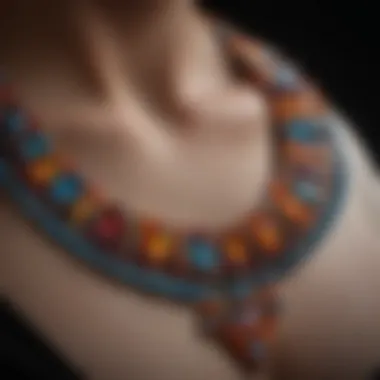
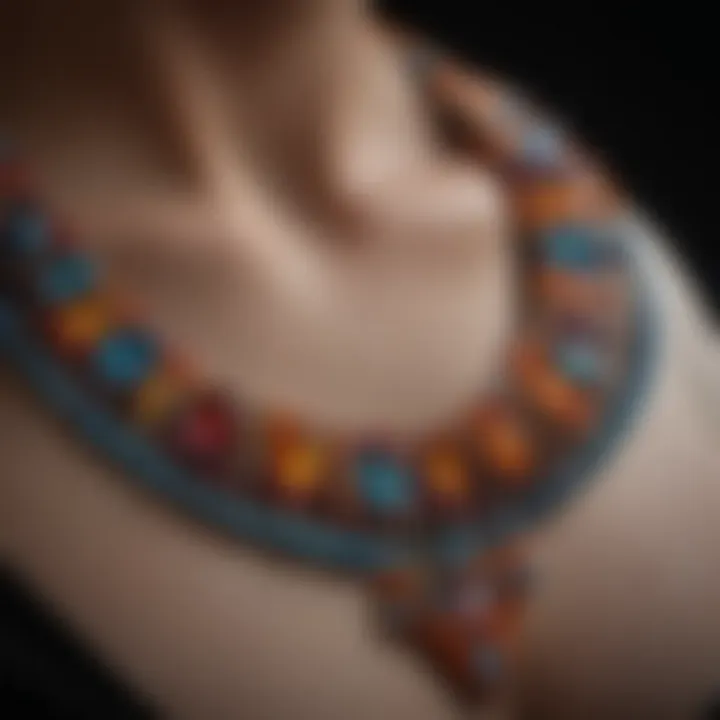
Exploration of Color and Texture
Color plays a pivotal role in the appeal of beaded necklaces. Vibrant hues can grab attention, while softer shades can evoke feelings of calmness. The interplay of colors not only attracts the eye but also communicates emotions and themes. For example, warmer colors like red and orange often represent passion and energy. In contrast, blues and greens are associated with tranquility and nature.
Texture also adds depth to the design. Different materials, such as smooth gemstones or carved wooden beads, create various tactile experiences. The contrast in textures can elevate the visual interest of the necklace. A necklace might combine polished stones with rough-hewn wooden beads, creating a striking contrast that invites closer inspection. This variety allows makers to express their artistic visions while providing buyers with options that suit their personal tastes.
Symbolism in Beaded Necklace Designs
Symbolism is another significant aspect of beaded necklaces. Many cultures attribute specific meanings to certain colors, materials, or patterns. For example, a necklace made with turquoise beads is often considered to promote protection and healing. Similarly, beads in particular arrangements can signify personal events, such as milestones in one’s life or family heritage.
This connection to symbolism can lead to a deeper appreciation by the wearer. Choosing a necklace that resonates personally adds another layer of significance beyond aesthetics. For those crafting custom pieces, understanding and incorporating symbolism can heighten the emotional connection to the jewelry, making it not only a fashion choice but also a statement of identity or beliefs.
"Beaded necklaces merge beauty with meaning, creating not just an accessory, but a narrative woven into every strand."
Beaded Necklaces in Contemporary Fashion
Beaded necklaces have taken a significant place in contemporary fashion. Their ability to blend tradition with modern styling makes them especially appealing. Today, these necklaces do not just serve as mere accessories; they often communicate personal identity and cultural heritage. The versatility in design and the dynamic range of materials available allow artisans and designers to create pieces that resonate with current styles and trends. As a result, beaded necklaces are becoming essential in many wardrobes, crossing lines between high fashion and street style.
Trends Influencing Current Styles
In the fast-paced world of fashion, trends come and go. Yet, beaded necklaces maintain a steady presence. Popularity amongst designers stems from their unique ability to adapt. Here are a few trends influencing beaded necklaces:
- Eclectic Mixing: Layering beads of different sizes and styles continues to be a staple. This allows individuals to express personal taste and creativity.
- Natural Materials: There is a move towards sustainability with a preference for natural materials such as stones, wood, and bone. Consumers are more conscious about where their fashion comes from.
- Customization: Personalized necklaces are on the rise. Custom options allow for the inclusion of initials, specific colors, or themes, which cater to individual style narratives.
- Cultural Fusion: Designers incorporate elements from various cultures, creating fusion pieces. This not only celebrates diversity but also introduces unique aesthetics.
The influence of these trends implies a larger acceptance of beaded necklaces in different contexts, making them suitable for both casual and formal occasions.
Accessorizing with Beaded Necklaces
Accessorizing with beaded necklaces involves more than just donning a piece of jewelry. It signifies a careful consideration of the overall look and the statement one wishes to make. Here are some key points about how to effectively accessorize:
- Pairing with Outfits: Beaded necklaces can enhance both simple and elaborate outfits. For a casual look, a single strand of colorful beads paired with a plain t-shirt can create a styled vibe. Alternatively, multiple layered necklaces can complement an elegant dress.
- Balance and Proportion: The length of the beaded necklace plays a crucial role. Shorter necklaces can enhance a V-neck top, while longer pieces work well over high-neck garments. Understanding proportions helps in achieving harmony in your overall appearance.
- Color Coordination: Matching the colors of your beaded necklace with your outfit can tie a look together. However, contrasting colors can also provide visual interest and help the necklace stand out.
- Consider the Occasion: The context of where one is going should guide the choice of necklace. Bright, playful designs might work for informal gatherings, whereas more refined and subdued colors might be more suitable for formal events.
Beaded necklaces encapsulate individual style and cultural significance while being adaptable to various fashion landscapes.
In essence, beaded necklaces play a pivotal role in contemporary fashion. Their ability to adapt and thrive amid evolving trends is remarkable. As fashion continues to evolve, beaded necklaces will likely remain essential accessories, bridging gaps between personal expression and cultural storytelling.
Personal Expression Through Beaded Necklaces
Beaded necklaces serve as a profound means for personal expression, transcending mere ornamentation. Each piece reflects the individuality of its wearer, making these jewelry items more than just decorative accessories. The uniqueness of beaded necklaces lies in their diverse designs, materials, and craftsmanship. This article section delves into the significance of personal identity embodied within these creations.
Crafting Unique Identity
Every beaded necklace tells a story, often representing the wearer's personal journey or aesthetic preferences. The selection of colors, materials, and patterns can signify personal style and cultural background. For instance, some individuals may opt for earthy tones and natural materials, reflecting a connection to nature and authenticity. Others might choose vibrant colors and bold designs, showcasing their adventurous spirit or artistic inclinations.
"Artistic expressions through jewelry can convey messages that words may fail to express."
Crafting your own unique identity through beaded necklaces can also involve DIY projects. Using diverse beads, including gemstone, wood, or ceramic, allows individuals to blend various elements that resonate with them personally. The act of creating a necklace can itself be a form of therapy, offering satisfaction and the freedom to articulate one’s style through tangible expressions.
Association with Spiritual Practices
Beaded necklaces are often intertwined with spiritual practices, lending them even greater meaning. Many cultures incorporate beading into rituals and ceremonies, using necklaces as tools for meditation or as symbols of faith. For instance, in certain spiritual traditions, specific stones are believed to hold healing properties, which can amplify personal intentions when worn.
In addition, some people wear beaded necklaces as talismans or protective charms, invoking guidance or strength in their lives. The process of choosing significant beads, such as those representing protection, love, or clarity, further enhances the personal connection one has with the necklace. This practice transforms what could be a simple piece of jewelry into an object infused with purpose and meaning.
Care and Maintenance of Beaded Necklaces
Care and maintenance of beaded necklaces is essential for preserving their beauty and extending their lifespan. This aspect of ownership is often overlooked. However, neglecting proper care can lead to irreversible damage. This section discusses key elements of maintaining beaded necklaces as well as benefits and considerations to keep in mind.
Cleaning Techniques for Various Materials
Cleaning beaded necklaces must be approached with caution, as different materials require specific methods.
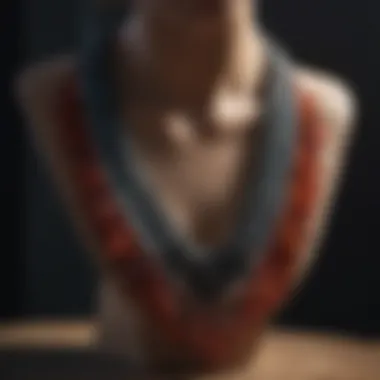
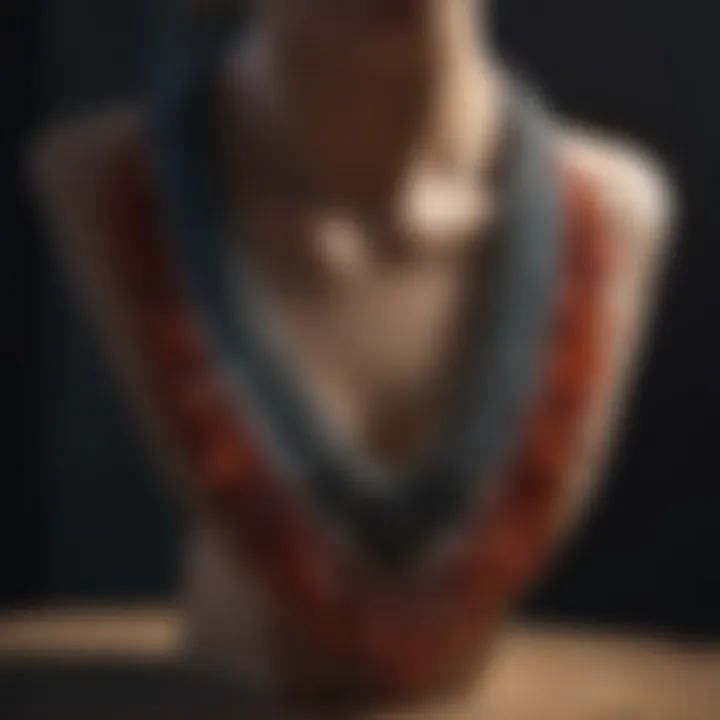
- Natural Materials: For necklaces made of wood or natural stones, gently wipe them with a soft, damp cloth. Avoid soaking as it can damage the material. A gentle soap can be used for deeper cleaning, but make sure to dry the necklace thoroughly to prevent moisture retention.
- Synthetic Materials: Necklaces made with plastics or resins can be cleaned using a mild soap solution. Wipe them with a soft cloth. Steer clear of abrasive cleaners that can scratch the surface.
- Metals: For metal beads, specific care is vital. Use a soft cloth to wipe down the necklace. If tarnishing occurs, use a metal polish designated for jewelry. Avoid using harsh chemicals which may damage the finish.
Always check manufacturer guidance if available, as they may provide unique cleaning recommendations based on the materials used.
Proper Storage Methods
Storing beaded necklaces properly prevents damage and maintains their appearance. Here are some effective methods:
- Individual Storage: Each necklace should ideally be stored individually. This prevents them from tangling or scratching against each other.
- Use Soft Bags: Pouches made from soft fabric can absorb moisture and prevent friction. Consider cotton or silk pouches for better protection.
- Jewelry Boxes: If using a jewelry box, choose one with compartments. Hard cases also offer excellent protection against physical damage.
- Avoid Direct Sunlight: Store necklaces away from direct sunlight. Prolonged exposure can fade colors in beads and materials.
In summary, effective care and maintenance allow your beaded necklaces to remain stunning and wearable for years to come. Regular cleaning routines and proper storage solutions can significantly impact their longevity.
Investing time in care ensures the preservation of emotional and financial value in your cherished pieces.
Beaded Necklaces as Gifts
Beaded necklaces have long served as poignant gifts that carry significant meaning. This section explores the unique aspects of giving these adornments, emphasizing their personal and emotional resonance. Choosing a beaded necklace as a gift can symbolize affection, memorable moments, or an important milestone. With a rich history behind them, these necklaces offer not just aesthetic appeal but also a narrative, making them a meaningful choice for any recipient.
Choosing the Right Necklace for Special Occasions
Selecting the right beaded necklace can depend greatly on the occasion. Here are a few considerations to keep in mind:
- Understanding the Recipient’s Taste: Take time to observe or inquire about the person’s style preferences. Some might favor bold colors while others may lean towards subtle tones.
- Context of the Occasion: Different events call for different styles. A wedding might necessitate elegant, refined pieces, whereas a birthday celebration could allow for more playful, vibrant designs.
- Themes and Symbolism: Certain beads hold specific meanings. For example, turquoise is often associated with good fortune, while amethyst is thought to promote calmness. Matching these meanings to the occasion can enhance the sentiment behind the gift.
- Practical Considerations: The length and clasp of the necklace can also play a role. A longer necklace may be more versatile for layering, while a shorter one might be best suited for formal settings.
It’s essential to consider not just the visual appeal of the necklace but also how it aligns with the significance of the occasion.
Personalized Beaded Gifts
Personalization adds a layer of distinctiveness to any gift, particularly with beaded necklaces. Here are some ways to achieve that:
- Custom Designs: Some artisans offer the option to create bespoke necklaces. This could involve selecting specific beads that are significant to the recipient, like their birthstone or a favorite color.
- Engraved Elements: Including small charms or tags with initials or meaningful dates can render a necklace truly unique. It serves as a constant reminder of a special bond or event.
- Storytelling with Beads: Each type of bead has origins and meanings. Selecting beads that tell a story or signify shared experiences makes the necklace more than a mere accessory.
Personalized beaded gifts highlight thoughtfulness and creativity, ensuring recipients not only appreciate them but also treasure their significance.
The Future of Beaded Necklaces
The realm of beaded necklaces continues to evolve, carrying historical significance while adapting to contemporary trends. Understanding the future of beaded necklaces is crucial for enthusiasts, collectors, and designers alike. This section closely examines emerging trends, innovations, and sustainability efforts that are shaping the future landscape of beaded jewelry. By exploring these elements, one can appreciate how traditional art forms can integrate with modern practices, thus enhancing their value and relevance.
Emerging Trends and Innovations
In recent years, various trends have surfaced in the domain of beaded necklaces. One prominent trend is the embrace of technology in bead design and crafting. Techniques such as 3D printing allow creators to design intricate shapes and patterns that were previously unattainable. Moreover, digital platforms enable designers to showcase their work globally, drawing in a more diverse audience. This combination of technology and art opens new avenues for creative expression.
Another trend is personalization. Consumers increasingly seek unique pieces that reflect their individuality. Customization options are now standard. This can range from selecting bead types that hold personal significance to incorporating letters or symbols that resonate with the wearer’s identity.
Additionally, the revival of vintage and artisan styles has gained traction. Many consumers are looking for authenticity and craftsmanship in their jewelry. This trend highlights a desire to connect with the past while still engaging with modern aesthetics.
Sustainability in Beaded Jewelry Making
The importance of sustainability cannot be overstated in today's consumer landscape. As awareness of environmental issues grows, jewelry makers are being called to adopt practices that minimize ecological impact. Many artisans are turning to sustainable materials, such as ethically sourced stones and recycled metals. This movement not only reduces resource depletion but also appeals to eco-conscious consumers.
Additionally, some designers focus on supporting local communities by sourcing materials within their geographical region. This ensures the preservation of traditional crafting techniques while also boosting local economies.
Furthermore, initiatives surrounding the life cycle of products are gaining popularity. More beaded jewelry creators are encouraging proper care and maintenance of their pieces, promoting longevity rather than disposability. Through education on how to care for beaded necklaces, consumers learn to cherish their items, which contributes to a more sustainable approach in jewelry consumption.
"An item of jewelry has the potential to tell a story, and its enduring value is as much about the materials as it is about the craftsmanship."
In summary, the future of beaded necklaces is significant both from an artistic and environmental standpoint. Emerging trends indicate a shift towards enhanced personalization and technological innovations, while sustainability remains at the forefront of consumer concerns. By embracing these developments, the art of beading not only survives but thrives in a contemporary context.
Finale
The significance of beaded necklaces goes far beyond mere adornment. They encapsulate a rich history, embodying the craftsmanship and creativity of diverse cultures throughout the ages. This article explored various factors contributing to their enduring allure, from the materials used to the intricate techniques of beading.
Understanding the aesthetics is crucial. Color and texture in beaded necklaces play vital roles in expressing personal style. Each piece tells a story, often reflecting the identity of the wearer and their cultural background.
Moreover, the contemporary relevance of beaded necklaces continues to evolve. As trends shift, so do the styles and meanings associated with these artistic creations. The influence of social media and global connectivity has allowed artisans to showcase their work, bringing new life to traditional designs.
It is important to consider care and maintenance as these aspects extend the lifespan of these cherished items. Proper cleaning techniques and storage practices not only preserve their beauty but also enhance their sentimental value.
Finally, the future of beaded necklaces looks promising. The increasing focus on sustainability in jewelry-making practices has influenced both consumers and creators. As more people become aware of the environmental impact of their purchases, the demand for ethically sourced materials is rising.



